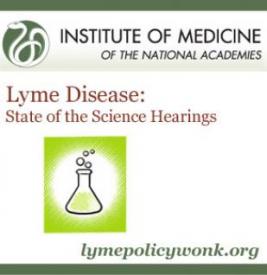IOM LIVE PODCASTS

Podcasts from the Institute of Medicine: Lyme Disease: State of Science Hearings
On April 29, the Institute of Medicine’s (IOM) Committee on Lyme Disease and Other Tick-borne Diseases: The State of Science held its first meeting in Washington, DC. Audio clips of the session are provided below. The open session lasted from 12:30pm to 5 pm. 2.5 hours were dedicated to presentations by government agencies and 1.75 hours were provided for patient comments, which were limited to 5 minutes each. The time limitation on patients resulted in a scatter shot approach. It is very difficult to make cogent points within 5 minutes. The limitation also meant that, as a practical matter, only patients close to the DC area would commit to the journey.
What does the Lyme community make of the session? Opinions may vary, but my take on the government presentations is that while some were interesting, most were focused on ecology and none were focused on the critical need of seriously ill patients to timely health care that restores their health. The agenda for the open session is available here. I kept a live blog of the event and speeches of some of the patients as well as my commentaries are posted on my blog (lymepolicywonk.org). The open session on April 29th was followed by a closed session on April 30th. Are anybody’s ears burning? Enjoy the show. Let’s hope the ending is both unexpected and joyous.
To listen to the Podcasts from the Lyme Disease: State of Science Hearings, click on the audio icon or title of the podcast.
Ms. Harper described the charge given by the NIAID to the IOM for this State of the Art conference. The charge is very important and I suggest you listen to it. |
Dr. Beards presentation focused on strengthening national surveillance, prevention, the need for improving diagnostics and treatment, and the need to identify all pathogens in the tick. |
Speech focused on information on the environmental impact of control efforts and eco factors that affect tick abundance and distribution as well as the need to identify reservoir hosts. |
Focus of talk was on deer targeted delivery technologies for controlling the tick population using tick vaccines, pesticides, and contraceptives to treat white tail deer to deliver to ticks. |
Presentation focused on information regarding the eco-factors that affect tick abundance. |




















great to be able to hear these podcasts